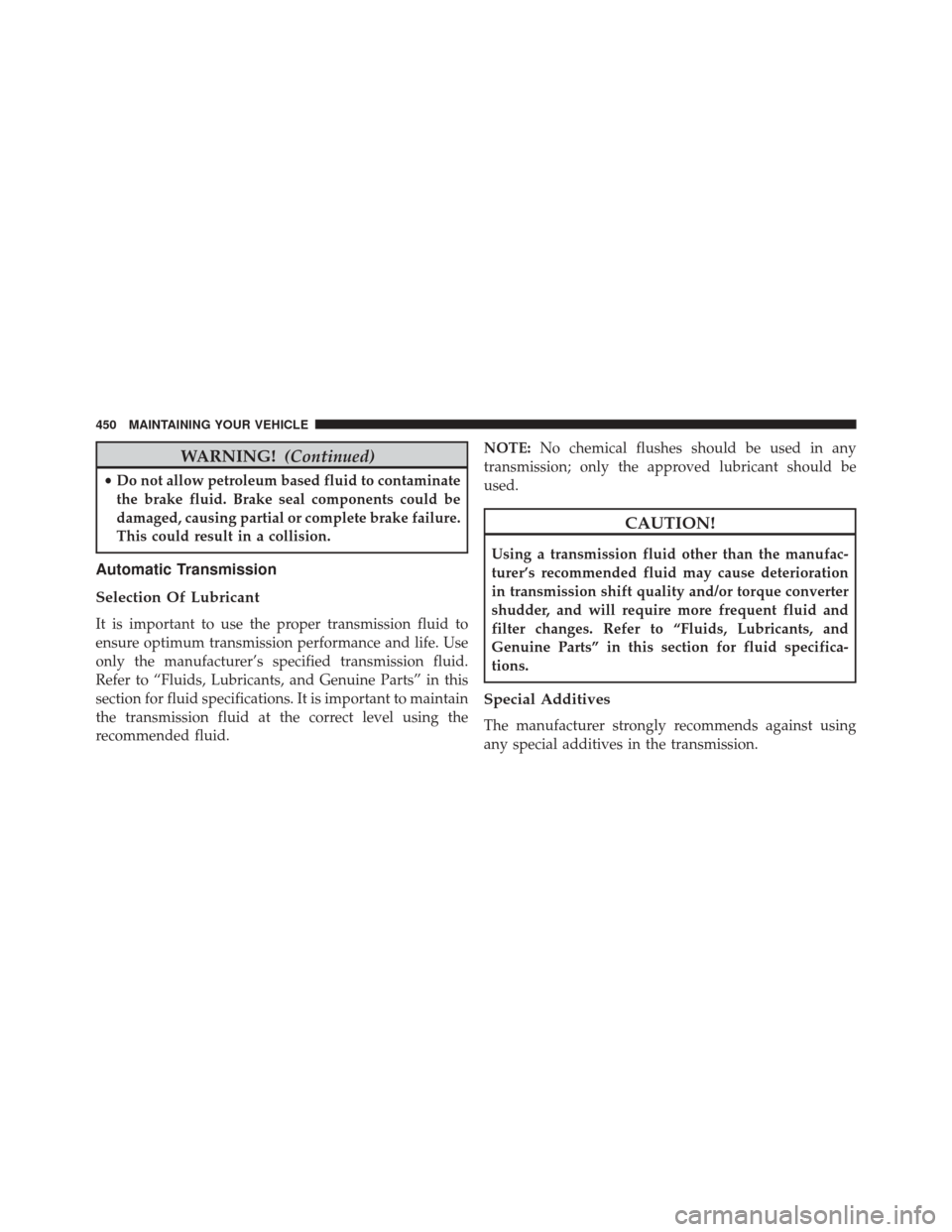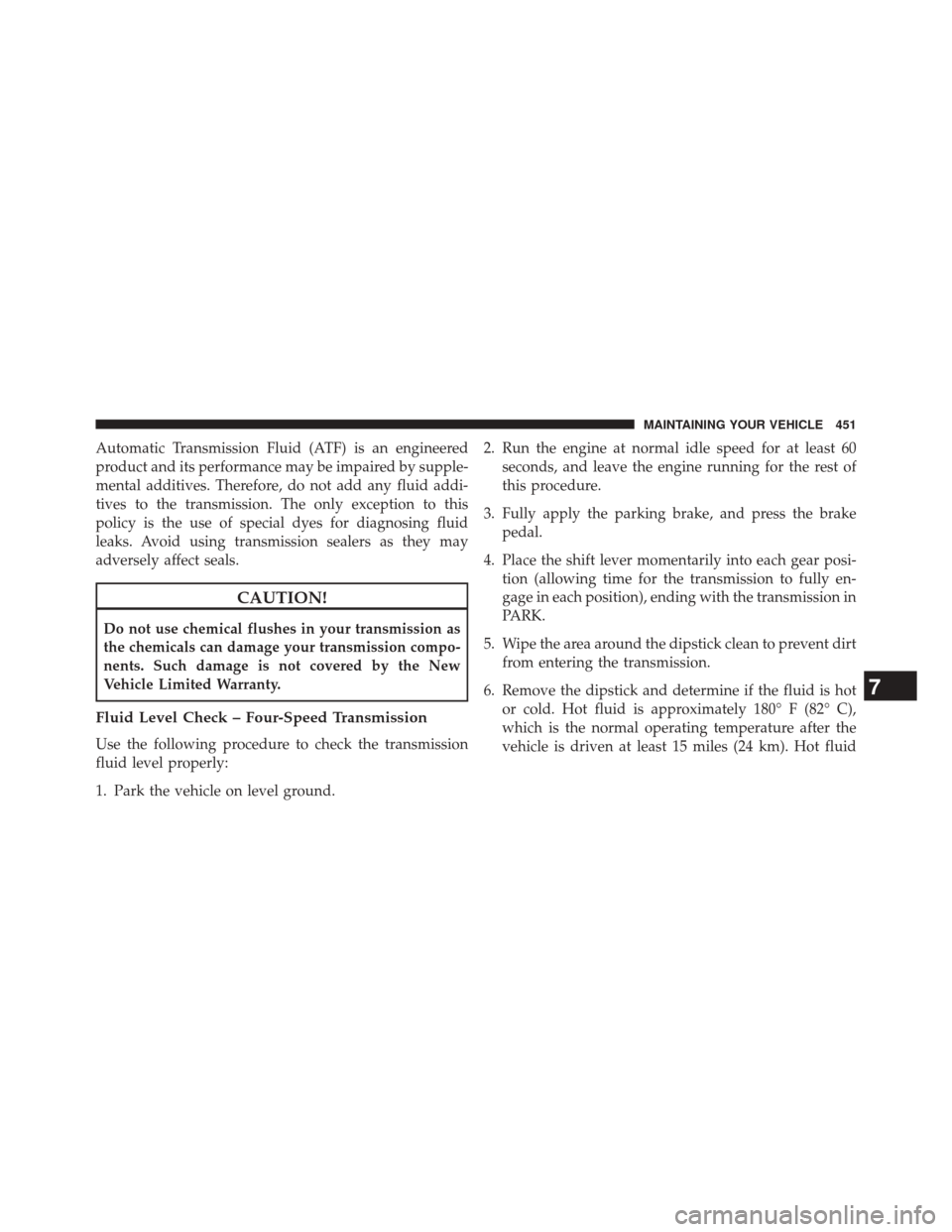Page 424 of 522
▫Brake System ....................... .448
▫ Automatic Transmission ................450
▫ Appearance Care And Protection From Corrosion
................................. .454
▫ Cleaning Center Console Cupholders ........459
▫ Convertible Top Care ...................460
▫ Weather Strip Care – Soft And Hard Top .....462
� FUSES ............................. .463
▫ Integrated Power Module ...............464
� VEHICLE STORAGE ....................470
� REPLACEMENT BULBS .................470 �
BULB REPLACEMENT ..................471
▫ Headlamp ......................... .471
▫ Front Turn Signal .....................474
▫ Front Fog Lamp ..................... .475
▫ Backup Lamps ...................... .475
▫ License Plate Lamp ....................477
� FLUID CAPACITIES ....................477
�
FLUIDS, LUBRICANTS AND GENUINE PARTS . .478
▫ Engine ............................ .478
▫ Chassis ........................... .480
422 MAINTAINING YOUR VEHICLE
Page 425 of 522
ENGINE COMPARTMENT — 2.4L
1 — Engine Coolant Reservoir5 — Integrated Power Module (Fuses) 9 — Coolant Pressure Cap
2 — Power Steering Fluid Reservoir 6 — Power Distribution Center (Fuses) 10 — Engine Oil Dipstick
3 — Automatic Transmission Dipstick 7 — Air Cleaner Filter 11 — Washer Fluid Reservoir
4 — Brake Fluid Reservoir 8 — Engine Oil Fill
7
MAINTAINING YOUR VEHICLE 423
Page 431 of 522

CAUTION!(Continued)
•Your vehicle has been built with improved fluids
that protect the performance and durability of your
vehicle and also allow extended maintenance inter-
vals. Do not use chemical flushes in these compo-
nents as the chemicals can damage your engine,
transmission, power steering or air conditioning.
Such damage is not covered by the New Vehicle
Limited Warranty. If a flush is needed because of
component malfunction, use only the specified
fluid for the flushing procedure.
Engine Oil
Checking Oil Level
To assure proper engine lubrication, the engine oil must
be maintained at the correct level. Check the oil level at
regular intervals, such as every fuel stop. The best time to
check the engine oil level is about five minutes after a fully warmed engine is shut off. Do not check oil level
before starting the engine after it has sat overnight.
Checking engine oil level when the engine is cold will
give you an incorrect reading.
Checking the oil while the vehicle is on level ground and
only when the engine is hot, will improve the accuracy of
the oil level readings. Maintain the oil level between the
range markings on the dipstick. Either the range mark-
ings consist of a crosshatch zone marked SAFE or a
crosshatch zone marked with MIN at the low end of the
range and MAX at the high end of the range. Adding one
quart of oil when the reading is at the low end of the
range marking will raise the oil level to the high end of
the range marking.
7
MAINTAINING YOUR VEHICLE 429
Page 452 of 522

WARNING!(Continued)
•Do not allow petroleum based fluid to contaminate
the brake fluid. Brake seal components could be
damaged, causing partial or complete brake failure.
This could result in a collision.
Automatic Transmission
Selection Of Lubricant
It is important to use the proper transmission fluid to
ensure optimum transmission performance and life. Use
only the manufacturer’s specified transmission fluid.
Refer to “Fluids, Lubricants, and Genuine Parts” in this
section for fluid specifications. It is important to maintain
the transmission fluid at the correct level using the
recommended fluid. NOTE:
No chemical flushes should be used in any
transmission; only the approved lubricant should be
used.
CAUTION!
Using a transmission fluid other than the manufac-
turer’s recommended fluid may cause deterioration
in transmission shift quality and/or torque converter
shudder, and will require more frequent fluid and
filter changes. Refer to “Fluids, Lubricants, and
Genuine Parts” in this section for fluid specifica-
tions.
Special Additives
The manufacturer strongly recommends against using
any special additives in the transmission.
450 MAINTAINING YOUR VEHICLE
Page 453 of 522

Automatic Transmission Fluid (ATF) is an engineered
product and its performance may be impaired by supple-
mental additives. Therefore, do not add any fluid addi-
tives to the transmission. The only exception to this
policy is the use of special dyes for diagnosing fluid
leaks. Avoid using transmission sealers as they may
adversely affect seals.
CAUTION!
Do not use chemical flushes in your transmission as
the chemicals can damage your transmission compo-
nents. Such damage is not covered by the New
Vehicle Limited Warranty.
Fluid Level Check – Four-Speed Transmission
Use the following procedure to check the transmission
fluid level properly:
1. Park the vehicle on level ground.2. Run the engine at normal idle speed for at least 60
seconds, and leave the engine running for the rest of
this procedure.
3. Fully apply the parking brake, and press the brake pedal.
4. Place the shift lever momentarily into each gear posi- tion (allowing time for the transmission to fully en-
gage in each position), ending with the transmission in
PARK.
5. Wipe the area around the dipstick clean to prevent dirt from entering the transmission.
6. Remove the dipstick and determine if the fluid is hot or cold. Hot fluid is approximately 180° F (82° C),
which is the normal operating temperature after the
vehicle is driven at least 15 miles (24 km). Hot fluid
7
MAINTAINING YOUR VEHICLE 451
Page 454 of 522

cannot be held comfortably between the fingertips.
Cold fluid is at a temperature of approximately 80° F
(27° C).
7. Wipe the dipstick clean and reinsert it until seated. Then, remove the dipstick and note the fluid level on
both sides. The fluid level reading is only valid if there
is a solid coating of oil on both sides of the dipstick.
Note that the holes in the dipstick will be full of fluid
if the actual level is at or above the hole.
• If the fluid is hot, the fluid level should be in the
crosshatched area marked “HOT” (between the up-
per two holes in the dipstick).
• If the fluid is cold, the fluid level should be between
the lower two holes in the area marked “COLD.”
If the fluid level is low, add fluid through the dipstick
tube to bring it to the proper level. Do not overfill. After
adding any quantity of oil through the dipstick tube, wait
at least two minutes for the oil to fully drain into the transmission before rechecking the fluid level.
8. Check for leaks. Release the parking brake.
To prevent dirt and water from entering the transmission
after checking or replenishing fluid, make sure that the
dipstick cap is properly reseated.
CAUTION!
•
Using a transmission fluid other than the manufac-
turer’s recommended fluid may cause deterioration
in transmission shift quality and/or torque con-
verter shudder, and will require more frequent
fluid and filter changes. Refer to “Fluids, Lubri-
cants, and Genuine Parts” in this section for fluid
specifications.
(Continued)
452 MAINTAINING YOUR VEHICLE
Page 455 of 522

CAUTION!(Continued)
•Dirt and water in the transmission can cause seri-
ous damage. To prevent dirt and water from enter-
ing the transmission after checking or replenishing
fluid, make sure that the dipstick cap is re-seated
properly.
Fluid Level Check – Six-Speed Transmission
The fluid level is preset at the factory and does not
require adjustment under normal operating conditions.
Routine fluid level checks are not required, therefore the
transmission filler tube is capped and no dipstick is
provided. Your authorized dealer can check your trans-
mission fluid level using a special service dipstick. If you
notice fluid leakage or transmission malfunction, visit
your authorized dealer immediately to have the trans-
mission fluid level checked. Operating the vehicle with an improper fluid level can cause severe transmission
damage.
CAUTION!
•
If a transmission fluid leak occurs, visit your au-
thorized dealer immediately. Severe transmission
damage may occur. Your authorized dealer has the
proper tools to adjust the fluid level accurately.
Fluid And Filter Changes
Refer to the “Maintenance Schedule” for the proper
maintenance intervals.
In addition, change the fluid and filter if the fluid
becomes contaminated (with water, etc.), or if the trans-
mission is disassembled for any reason.
7
MAINTAINING YOUR VEHICLE 453
Page 482 of 522
ComponentFluid, Lubricant, or Genuine Part
Spark Plugs – 3.6L Engine We recommend you use MOPAR® Spark Plugs (Gap
0.043 in [1.1 mm]).
Fuel Selection 87 Octane
* PZEV = Partial Zero Emission Vehicle
Chassis
Component Fluid, Lubricant, or Genuine Part
Automatic Transmission Use only ATF+4® Automatic Transmission Fluid. Fail-
ure to use ATF+4® fluid may affect the function or
performance of your transmission. We recommend
MOPAR® ATF+4® fluid.
Brake Master Cylinder We recommend you use MOPAR® DOT 3 and SAE
J1703. If DOT 3 brake fluid is not available, then DOT 4
is acceptable.
Power Steering Reservoir We recommend you use MOPAR® Power Steering Fluid
+4, MOPAR® ATF+4® Automatic Transmission Fluid.
480 MAINTAINING YOUR VEHICLE